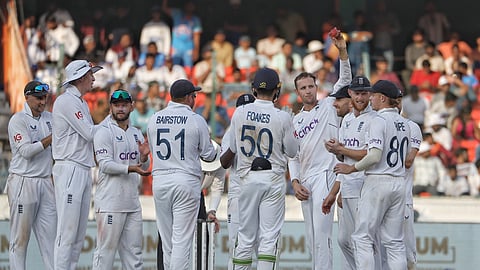

HYDERABAD: A member of the travelling Barmy Army played 'Rally 'Round The West Indies' as news started filtering that they had beaten Australia in Brisbane. A few hours later, as the shadows lengthened and artificial light started to replace the dimming natural light, they were creating quite the din in the city of pearls.
Not to be left behind, the locals — 25,000 or so — were whistling and cheering every run that was being scored by their boy Mohammed Siraj. They were also imploring Jasprit Bumrah to continue to block. Two of India's lead new-ball bowlers had pushed, prodded and chanced their way to a partnership of 25. They needed 29 more to seal what would have been one of the greatest last-wicket escape acts in the history of the game.
But Siraj, one of the few Indians to come down the track against the visiting spinners on Sunday, was stumped. Tom Hartley, who was offered some words of encouragement after a dispiriting first day of Test cricket (none for 63 in nine overs), had finished with seven wickets across 26.2 largely captivating overs. He found nothing to work with on the first day as Yashasvi Jaiswal prevented him from developing any rhythm.
However, this sport is fickle. Chasing 231 on a wicket that had plenty of variable bounce and turn — even if some of it was slow — Jaiswal was the first to go. On the first day, he was on 39 after 35 balls. But scoreboard pressure is a real thing. He wasn't looking to be proactive enough against the spinners. It allowed Hartley to settle. To be fair to Jaiswal, he was trying to mess with the debutant's line after staying in his crease during his short stay. So he stepped down. But the tall spinner saw him coming and shortened the length. In no man's land, the 22-year-old offered a chance to Ollie Pope at forward short-leg. Two balls later, Shubman Gill went back the way he had come; a tentative neither-here, nor-there prod. It was snaffled by Pope in the same region.
The floodgates had opened. A familiar story was being scripted. Indian batters losing wickets to spin on a challenging surface. Hartley's fif-er was the fourth by a visiting left-arm spinner since Steve O'Keefe (2017; Pune), Ajaz Patel (2021; Mumbai) and Matt Kuhnemann (2023; Indore). Jack Leach (2021; Chennai) and Praveen Jayawickrama (2022; Bengaluru) have picked up four-wicket hauls in this period. Staying in the sub-continent, both Taijul Islam and Shakib Al Hasan picked up four wickets each before Shreyas Iyer and R Ashwin took India home in a chase of 145 in 2022. Either by chance or by design, whenever a visiting left-arm spinner does well in India, it seems to be in a winning cause. This is India's third defeat at home since 2021 and all of the losses have seen significant contributions from them.
Is there a pattern? Coach Rahul Dravid opined that the batters could have played square of the wicket but stopped short of calling it a weakness against any particular spin type. "I think it's pretty good bowling," he said after the match. "The ball is spinning in the fourth innings. I thought we combated it pretty well in the first. When it gets to these kinds of situations, you have to give credit to the bowlers. They were able to pitch the ball in the right areas, pitch where it was challenging for us and spun the ball appreciably. I think using your feet to the left-hand spinner in these conditions is fraught with risk, probably you have to play a little bit more square of the wicket. Having said that, that's a high risk shot as well... (but) I don't see it as a huge issue. I think when you have a good left-hand spinner who's able to pitch it in line with the stumps, it's going to be a challenge. I think it's going to be something that we are going to have to counter and get better and develop some plans and strategies around (it)."
A few of the Indian batters tried to counter it on the go but it didn't affect their lines. Rohit Sharma did reverse sweep as did KS Bharat but there was no real conviction. The skipper in fact profited from it as he scored a boundary but that belief to keep playing it was lacking. He soon perished as England knew they could keep bowling those kinds of good length deliveries. It was the one big difference between the hosts and the visiting batters.
What Pope did was he constantly kept sweeping the spinners. So they had no choice but to change their length. When the batter you are bowling to can hit your best balls for four, you are constantly thinking. During that process, you are bound to get half-volleys or long-hops — a point Pope made in the press-conference. R Ashwin and Ravindra Jadeja may be world-class but they had to go away from their favoured lengths. Once you do that, you are in business.
All of Joe Root, Jack Leach and Hartley were in business on Sunday because they kept bringing the batter forward; they asked those questions which Ashwin and Jadeja usually ask but couldn't in this Test.
The end result? A black swan event. India had never lost a home Test after taking a lead in excess of 100 in 90 years of playing the game.